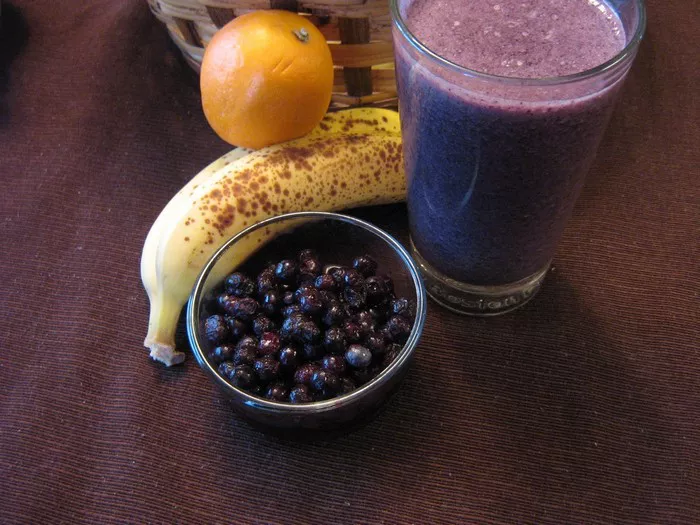Understanding the nutritional content of our food is crucial for maintaining a healthy lifestyle. Among the various beverages we consume, strawberry smoothies have gained immense popularity due to their refreshing taste and perceived health benefits. However, knowing how many calories are in a strawberry smoothie is essential for those watching their calorie intake. This article will delve into the calorie content of strawberry smoothies, their nutritional breakdown, and tips for making healthier choices.
Calorie Content of Strawberry Smoothies
The calorie content of a strawberry smoothie can vary significantly depending on its ingredients and preparation method. Generally, a standard serving of a strawberry smoothie contains approximately 160 calories. This figure can vary widely, though, as some smoothies may be loaded with extra sugar, cream, or other high-calorie ingredients.
To illustrate, let’s consider a specific example provided by a nutrition database. A serving of a strawberry smoothie might contain:
- Energy: 669 kilojoules (160 kilocalories)
- Protein: 2.96 grams
- Fat: 3.63 grams (including 0.378 grams of saturated fat, 2.575 grams of polyunsaturated fat, and 0.263 grams of monounsaturated fat)
- Cholesterol: 0 milligrams
- Carbohydrates: 31.25 grams (including 21.88 grams of sugar and 6.6 grams of fiber)
- Sodium: 55 milligrams
- Potassium: 404 milligrams
This nutritional breakdown indicates that the majority of calories in a strawberry smoothie come from carbohydrates (74%), followed by fat (19%) and protein (7%).
Nutritional Breakdown
Understanding the nutritional breakdown of a strawberry smoothie helps us assess its overall health benefits. Here’s a closer look at each component:
Carbohydrates
Sugar: The high sugar content (21.88 grams per serving) is primarily due to the strawberries and possibly added sweeteners. While natural sugars from fruits are better than refined sugars, excessive intake can still lead to weight gain and other health issues.
Fiber: The 6.6 grams of fiber per serving is beneficial for digestion and can help you feel full longer, potentially aiding in weight management.
Fat: The fat content in a strawberry smoothie is relatively low but still significant. The majority is unsaturated fat, which is considered healthier than saturated fat. However, it’s important to monitor your total fat intake, especially if you’re trying to lose weight or maintain a healthy weight.
Protein: With only 2.96 grams of protein per serving, strawberry smoothies are not a significant source of this macronutrient. If you’re looking to increase your protein intake, consider adding a scoop of protein powder or some Greek yogurt to your smoothie.
Other Nutrients
Potassium: The 404 milligrams of potassium per serving is essential for maintaining healthy blood pressure and heart function.
Sodium: The low sodium content (55 milligrams per serving) is beneficial for those watching their sodium intake, as excessive sodium can lead to high blood pressure.
Factors Affecting Calorie Content
Several factors can influence the calorie content of a strawberry smoothie:
Ingredients:
- The type and amount of ingredients used can significantly affect the calorie count. For example, adding banana, avocado, or nut butter can increase the fat and calorie content.
- Using low-fat dairy or plant-based milk alternatives can help reduce the calorie and fat content.
Portion Size: Larger portions naturally contain more calories. Be mindful of portion sizes when preparing or ordering smoothies.
Added Sugars: Many commercial smoothies contain added sugars, which can significantly boost the calorie count. Opt for smoothies made with natural ingredients and minimal added sugars.
Preparation Method: Blending fruits with ice or using frozen fruits can affect the consistency and calorie content. While these additions don’t significantly alter the calorie count, they can impact the overall volume and satisfaction you get from the smoothie.
Making Healthier Choices
If you enjoy strawberry smoothies but are concerned about their calorie content, here are some tips for making healthier choices:
Choose Fresh Ingredients: Use fresh or frozen strawberries and other fruits instead of canned or juiced fruits, which may contain added sugars.
Control the Sweeteners: Limit the use of added sugars, honey, or syrups. If you need sweetness, consider using a natural sweetener like stevia or monk fruit extract.
Add Protein: Incorporate protein sources like Greek yogurt, protein powder, or even a handful of spinach (which is packed with nutrients but low in calories).
Use Healthy Fats: Add a small amount of healthy fats like chia seeds, flaxseeds, or a nut butter to boost the nutritional profile and satiety.
Watch the Portion Size: Be mindful of portion sizes, especially if you’re consuming smoothies as a meal replacement. Aim for a balanced intake of macronutrients to meet your daily nutritional needs.
Make It at Home: Making smoothies at home gives you control over the ingredients and portion sizes. You can customize your smoothie to suit your taste preferences and nutritional needs.
Conclusion
Strawberry smoothies are a refreshing and nutritious beverage choice, but their calorie content can vary widely depending on the ingredients and preparation method. By understanding the nutritional breakdown and factors affecting the calorie content, you can make healthier choices when enjoying this tasty treat. By selecting fresh ingredients, controlling sweeteners, adding protein and healthy fats, and watching portion sizes, you can create a strawberry smoothie that is both delicious and nutritious. Remember, moderation is key, and enjoying a strawberry smoothie as part of a balanced diet can contribute to overall health and well-being.
Related Topics:


























